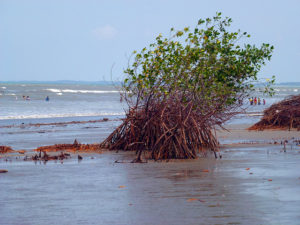
As global conservation awareness about mangroves, salt marshes and other coastal ecosystems continues to grow, seagrass meadows are being left at the bottom.
Hidden underwater, seagrass meadows may cover less than .2% of the ocean floor, but they are responsible for an estimated 10% or more of the ‘blue’ carbon sequestered by the ocean each year – storing only slightly less carbon per hectare than well-known mangrove ecosystems. And unlike forests, which rerelease the carbon they store after decades or centuries, seagrass meadows can hold onto their carbon stocks for millennia.
Lung-like in function, 1 square meter of seagrass can generate 10 liters of oxygen daily to its surrounding waters while filtering out pollutants and adding in nutrients that feed its inhabitant manatees, turtles, seahorses, sharks and dugong – as well as fisheries. A recent study says seagrass meadows are grounds for a fifth of the world’s top 25 fisheries, making them crucial to global food security and livelihoods.
Yet, these ecosystems are rapidly deteriorating, their rate of decline increasing from .9% before 1940 to 7% since 1990. In total, an estimated 29% of all seagrass meadows have vanished. Scientists say this rate is equal to the loss of a football field’s worth of seagrass every half hour.
In consequence, seagrass carbon stocks can be – and often are – released in an instant. Warmer waters from climate change, or the drop of an anchor, can unearth carbon that has been stored for thousands of years.
At the recent Blue Carbon Summit in Jakarta, researchers examining seagrass in Indonesia shared findings on these under-researched ecosystems, and what needs to be done to ensure their longevity going forward.
Read also: Failure to manage blue carbon ecosystems could break the internet

FROM THE LAND TO THE SEA
About 100 million years ago, species of flowering plants migrated from terrestrial to aquatic environments, maintaining their roots, veins, and ability to produce flowers and seeds as they went. More closely related to palms and lilies than their much-simpler seaweed doppelgangers, seagrass reproduces via hydrophilic pollination and exchanges nutrients and gases with water through its leaves.
Now, some 72 species of seagrass exist around the world, varying in adaptation across different latitudes, water temperatures, tides, wave exposure and sediment substrate types of the sea floor. They can make their home in sub-tidal depths of up to 40 meters, in mud and silt, in sand coarse or fine, in coral alive and dead, and in areas with other competing species.
Subsequently, the way seagrass stores carbon also varies from place to place, dependent on similar factors. If a meadow is composed of one or many seagrass species, the carbon storage is affected. If the species are big or small, the carbon storage is affected. If the water gets warmer, or size of sand particles gets larger, or a migratory species comes passing through, the carbon storage is affected.
Protecting, managing and restoring seagrass meadows, then, begins with knowing the site-specificity of species and carbon storage. Off the south coast of the Indonesian island of Sulawesi, for instance, Rohani Ambo-Rappe, Faculty of Marine and Fisheries at Hasanuddin University, found that meadows with high exposure to waves stored more carbon in the aboveground biomass of its seagrass, while low-exposure zones saw more carbon stored in roots below the sediment surface.
Meanwhile, in West and East Java, Dr. Devi Choesin from the Bandung Institute of Technology found that most carbon was stored below the sediment across the board, though with a great degree of variability. Given the wide number of contingencies at play, research methods for seagrass, she said, are difficult to standardize, contributing in part to the relative lack of data on seagrass so far.
“How much seagrass is left in Indonesia? If you ask 10 people, you’ll get 10 different answers,” said Tonny Wagey, Executive Director of the Indonesia Climate Change Trust Fund.
Read also: Governing mangroves: From Tanzania to Indonesia
FACTORING IN THE INVISIBLE
The reasons for the decline of seagrass range from the usual suspects – water pollution, plastic waste, eutrophication, tourism development – to the less obvious, such as overgrazing of sea turtles, waves and water currents.
But because of the extant lack of attention and scientific focus on these ecosystems, they have yet to be formally included in major global initiatives and platforms, such as REDD+ and the UNFCCC agenda.
Within the agenda of Indonesia – which has the second-largest seagrass landscape globally, after Australia – the ambitious national goal to reduce greenhouse gas emissions 26% by 2020 could use the help of seagrass, speakers at the Summit said, rather than putting all of the pressure on land-based ecosystems.
Sustainable management and development of seagrass in sectors such as fisheries can also contribute to the country’s Low Carbon Development initiative, as well as local enterprises making use of seagrass in its more traditional purposes: for fertilizer, furniture and building materials, and medical bandages and supplies. To meet President Joko Widodo’s bid to reduce plastic waste 70% by 2025, Coordinating Minister for Maritime Affairs and Natural Resources said that seagrass along with cassava can be used in lieu of plastic in drinking water bottles.
In the ‘white papers’ being developed by the Center for International Forestry Research (CIFOR) and partners to inform future Indonesian policy – a foremost outcome of the Summit – seagrass is included in the first recommendation, highlighting its crucial role in keeping pace with sea level rise, an important step toward changing the tide for these ecosystems.
Watch: Protecting North Sumatran mangroves, supporting biodiversity, people and the world
By Gabrielle Lipton, originally published at CIFOR’s Forests News.
This research forms part of the CGIAR Research Program on Forests, Trees and Agroforestry, which is supported by CGIAR Fund Donors.











